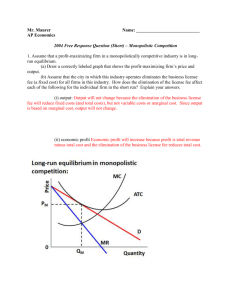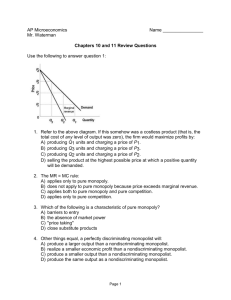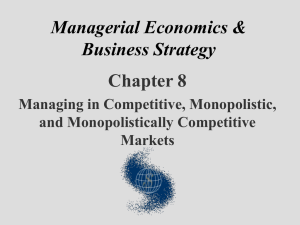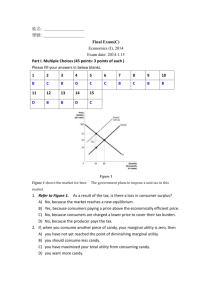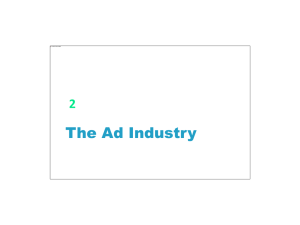Chapter 17 MC — Monopolistic Competition
advertisement
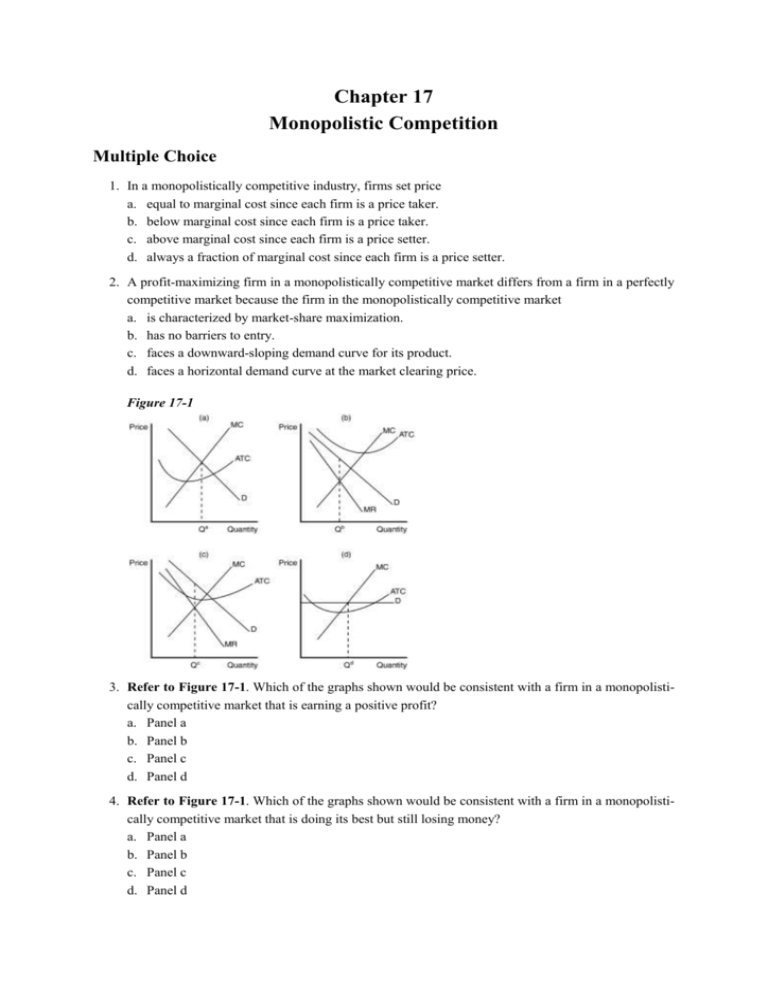
Chapter 17 Monopolistic Competition Multiple Choice 1. In a monopolistically competitive industry, firms set price a. equal to marginal cost since each firm is a price taker. b. below marginal cost since each firm is a price taker. c. above marginal cost since each firm is a price setter. d. always a fraction of marginal cost since each firm is a price setter. 2. A profit-maximizing firm in a monopolistically competitive market differs from a firm in a perfectly competitive market because the firm in the monopolistically competitive market a. is characterized by market-share maximization. b. has no barriers to entry. c. faces a downward-sloping demand curve for its product. d. faces a horizontal demand curve at the market clearing price. Figure 17-1 3. Refer to Figure 17-1. Which of the graphs shown would be consistent with a firm in a monopolistically competitive market that is earning a positive profit? a. Panel a b. Panel b c. Panel c d. Panel d 4. Refer to Figure 17-1. Which of the graphs shown would be consistent with a firm in a monopolistically competitive market that is doing its best but still losing money? a. Panel a b. Panel b c. Panel c d. Panel d 5. Refer to Figure 17-1. Which of the graphs depicts a monopolistically competitive firm in long-run equilibrium? a. Panel a b. Panel b c. Panel c d. None of the above is correct. 6. In the short run, a firm in a monopolistically competitive market operates much like a a. firm in a perfectly competitive market. b. firm in an oligopoly. c. monopolist. d. monopsonist. Figure 17-2 7. Refer to Figure 17-2. Panel (a) shows a profit-maximizing monopolistically competitive firm that is a. earning zero economic profit. b. likely to exit the market in the long run. c. producing its efficient scale of output. d. not maximizing its profit. 8. Refer to Figure 17-2. Which of the panels shown could illustrate the short-run situation for a monopolistically competitive firm? a. Panel a b. Panel b c. Panel c d. All of the above are correct. 9. Refer to Figure 17-2. Panel (b) is consistent with a firm in a monopolistically competitive market that is a. not in long-run equilibrium. b. in long-run equilibrium. c. producing its efficient scale of output. d. earning a positive economic profit. 10. Refer to Figure 17-2. Which of the panels depicts a firm in a monopolistically competitive market earning positive economic profits? a. Panel a b. Panel b c. Panel c d. Panel d 11. A profit-maximizing firm operating in a monopolistically competitive market that is in a long-run equilibrium has a. minimized average total cost. b. chosen to produce where demand is unitary elastic. c. produced the efficient scale of output. d. chosen a quantity of output where average revenue equals average total cost. 12. Product differentiation in monopolistically competitive markets ensures that, for profit-maximizing firms, a. marginal revenue will equal average total cost. b. price will exceed marginal cost. c. marginal cost will exceed average revenue. d. average variable cost will be declining. 13. The deadweight loss that is associated with a monopolistically competitive market is a result of a. price falling short of marginal cost in order to increase market share. b. price exceeding marginal cost. c. the firm operating in a regulated industry. d. excessive advertising costs. 14. Monopolistically competitive markets may be socially inefficient because a. most firms produce inferior products. b. government programs cannot effectively regulate price. c. firms earn zero economic profit. d. the market may have too much or too little entry by new firms. 15. When existing firms lose customers and profits due to entry of a new competitor, a a. predatory-pricing externality occurs. b. consumption externality occurs. c. business-stealing externality occurs. d. product-variety externality occurs. Scenario 17-1 Vacation Inns of America (VIA) has recently announced intentions of building a new hotel/resort complex in Myrtle Beach, South Carolina. Assume that the hotel/resort market in Myrtle Beach is characterized by monopolistic competition. 16. Refer to Scenario 17-1. As a result of the new VIA hotel/resort, tourists who stay in Myrtle Beach are likely to experience a a. product-variety externality, which harms consumers. b. product-variety externality, which benefits consumers. c. business-stealing externality, which harms consumers. d. business-stealing externality, which benefits consumers. 17. Refer to Scenario 17-1. Existing hotels, motels, and lodging facilities in Myrtle Beach are likely to experience what kind of externality as a result of the new VIA hotel/resort? a. Product-variety b. Business-stealing c. Competitive d. Advertising 18. In the long run, a monopolistically competitive firm produces a quantity that is a. equal to the efficient scale. b. less than the efficient scale. c. greater than the efficient scale. d. consistent with diseconomies of scale. 19. Monopolistically competitive markets differ from perfectly competitive markets due to (i) the number of sellers. (ii) the barriers to entry. (iii) the product differentiation among the sellers. a. (i) only b. (iii) only c. (i) and (iii) d. (ii) and (iii) 20. A downward-sloping demand curve a. is a feature of all monopolistically competitive firms. b. means that the firm in question will never experience a zero profit. c. causes marginal revenue to exceed price. d. prohibits firms from earning positive economic profits in the long run. 21. Examples of monopolistically competitive markets include the markets for a. restaurants and furniture. b. wheat and corn. c. postage stamps and wooden pencils. d. All of the above are correct. 22. When a market is monopolistically competitive, the typical firm in the market is likely to experience a a. positive profit in the short run and in the long run. b. positive or negative profit in the short run and a zero profit in the long run. c. zero profit in the short run and a positive or negative profit in the long run. d. zero profit in the short run and in the long run. 23. For a monopolistically competitive firm, at the profit-maximizing quantity of output, a. price exceeds marginal cost. b. marginal revenue exceeds marginal cost. c. marginal cost exceeds average revenue. d. price equals marginal revenue. 24. Suppose that monopolistically competitive firms in a certain market are experiencing losses. In the transition from this initial situation to a long-run equilibrium, a. b. c. d. the number of firms in the market decreases. each existing firm experiences a decrease in demand for its product. each firm experiences an upward shift to its marginal cost and average total cost curves. each existing firm’s average total cost falls to bring economic profit back to zero. 25. For a profit-maximizing monopolistically competitive firm, price exceeds marginal cost a. in the short run but not in the long run. b. in the long run but not in the short run. c. in both the short run and the long run. d. in neither the short run nor the long run. 26. In a long-run equilibrium, a. "excess capacity" applies to monopolistically competitive firms, but not to competitive firms. b. "zero economic profit" applies to competitive firms, but not to monopolistically competitive firms. c. "markup over marginal cost" applies to both monopolistically competitive and competitive firms. d. “product variety externalities” apply to both perfectly competitive firms and monopolistically competitive firms. 27. A monopolistically competitive firm faces the following demand curve for its product: Price ($) 10 9 8 7 6 5 4 3 2 1 Quantity 2 4 6 8 10 12 14 16 18 20 The firm has total fixed costs of $20 and a constant marginal cost of $5 per unit. The firm will maximize profit with the production of a. 6 units of output. b. 8 units of output. c. 10 units of output. d. 12 units of output. 28. A monopolistically competitive firm has the following cost structure: Output 1 2 3 4 5 6 7 Total Cost($) 30 32 36 42 50 63 77 The firm faces the following demand curve: Price ($) 20 18 15 12 Quantity 1 2 3 4 9 5 7 6 4 7 If the government forces this firm to produce at its efficient scale, it will a. produce 3 units and make $9. b. produce 4 units and make $6. c. produce 5 units and lose $5. d. produce 7 units and lose $49. Table 17-1 Quantity Price 0 1 10 9 2 8 Marginal Cost Average Total Cost --3 14 6 10 3 7 9 9 4 6 12 10 5 5 15 12 6 4 18 14 7 8 9 3 2 1 21 24 27 17 21 25 10 0 30 29 29. Refer to Table 17-1. This table shows the demand schedule, marginal cost, and average total cost for a monopolistically competitive firm. What price will this firm charge to maximize profit? a. $6 b. $7 c. $8 d. $9 30. Refer to Table 17-1. This table shows the demand schedule, marginal cost, and average total cost for a monopolistically competitive market. Which of the following is likely to happen in the long run in this market? a. The market is currently in a long-run equilibrium. b. The market price is likely to fall. c. Firms are likely to enter the market since firms are earning a positive economic profit. d. Firms are likely to leave the market since firms are earning a negative economic profit. 31. Refer to Table 17-1. This table shows the demand schedule, marginal cost, and average total cost for a monopolistically competitive firm. How much profit will this firm earn when it chooses its output to maximize profit? a. A $4 loss. b. A $2 loss. c. A $6 profit. d. A $16 profit. Table 17-2 Quantity 0 1 2 3 4 5 Price 20 16 12 8 4 0 Marginal Cost -2 4 6 8 10 Average Total Cost -21.00 12.00 9.67 9.00 9.00 32. Refer to Table 17-2. This table shows the demand schedule, marginal cost, and average cost for a monopolistically competitive firm. What price should this firm charge to maximize profit? a. $4 b. $8 c. $12 d. $16 33. Refer to Table 17-2. This table shows the demand schedule, marginal cost, and average cost for a monopolistically competitive firm. How much profit will this firm earn at the monopolistically competitive price? a. $0 b. $5 c. $12 d. $16 34. Refer to Table 17-2. Which of the following statements regarding this monopolistically competitive firm is true? a. New firms will enter this market in the long run since firm profits are greater than zero. b. Firms will leave this market in the long run since firm profits are less than zero. c. This firm is currently in long-run equilibrium. d. This firm is currently in long-run equilibrium, and the firm is producing its efficient scale of output. 35. Which of the following statements regarding monopolistic competition is false? a. In the long-run equilibrium, price equals average total cost. b. In the long-run equilibrium, firms earn zero economic profit. c. In the long-run equilibrium, firms charge a price above marginal cost. d. In the long-run equilibrium, firms produce a quantity in excess of their efficient scale. 36. Under which of the following market structures would consumers likely receive the most product variety? a. Perfect competition b. Monopolistic competition c. Oligopoly d. Monopoly 37. Which of the following is a characteristic of oligopoly or monopolistic competition, but not perfect competition? a. Advertising and sales promotion b. Profit maximization according to the MR = MC rule c. Firms being price takers rather than price makers d. Horizontal demand and marginal revenue curves 38. Cecilia's Café is in a monopolistically competitive market. Cecilia's is currently producing where average total cost is at its minimum, and Cecilia’s is earning a positive economic profit. In the long run we would expect Cecilia’s output to a. decrease and average total cost to increase. b. decrease and average total cost to decrease. c. remain unchanged as Cecilia's is doing the best it can. d. increase and average total costs to decrease. 39. Which of the following best describes the idea of excess capacity in monopolistic competition? a. Firms produce more output than is socially desirable. b. The output produced by a typical firm is less than what would occur at the minimum point on its ATC curve. c. Due to product differentiation, firms choose output levels where P > ATC. d. Firms keep some surplus output on hand in case there is a shift in the demand for their product. 40. The traditional view of monopolistic competition holds that this type of industrial structure is inefficient because a. there are too few firms to reach an efficient level of production. b. firms do not operate at the output that minimizes average costs. c. advertising is not used extensively enough to yield an efficient differentiation of the products. d. consumers do not have enough choice among the product varieties available. 41. When firms sell highly differentiated consumer goods, it is likely that a significant cost to the firms will be a. associated with advertising. b. associated with the product-variety externality. c. associated with intermediate materials. d. associated with taxes and regulation. 42. Results of the study done by Lee Benham on advertising for eyeglasses would suggest that a. brand loyalty and market power in the eyeglass market was likely to be more pervasive in states that allowed advertising. b. eyeglass sales were more profitable in states that allowed advertising. c. optometrists would not be supportive of advertising restrictions. d. optometrists would enthusiastically endorse advertising restrictions. 43. Advertisements that appear to convey no information at all a. are usually associated with "infomercials." b. are mostly useless to consumers, but valuable to firms. c. are mostly useless to firms, but valuable to consumers for their entertainment quality alone. d. may convey information to consumers by providing them with a signal that firms are willing to spend significant amounts of money to advertise. 44. If advertising reduces a consumer's price sensitivity between identical goods, it is likely to a. increase the elasticity of demand for differentiated products. b. enhance competition, and encourage more product diversity. c. reduce competition and reduce social welfare. d. encourage the consumption of all homogenous goods. 45. A law that restricts the ability of hotels/motels to advertise on billboards outside of a resort community would likely lead to a. a decrease in profits for all hotels/motels. b. reduced efficiency of local lodging markets. c. a request by consumers to increase the number of billboards. d. increased price competition among hotels/motels in the community. 46. It is a well-publicized fact that television advertisements aired during major sporting events are very expensive. A theory asserting that people buy a product simply because it is advertised would suggest that information on the high cost of advertising a. enhances the effectiveness of the advertisement. b. reduces people's willingness to purchase advertised products. c. is leaked to discredit the firms that spend so much on advertising. d. reduces the effective staying power of a product. 47. Which of the following is unique to a monopolistically competitive firm when compared to an oligopoly? a. The monopolistically competitive firm advertises. b. The monopolistically competitive firm produces a quantity of output that falls short of the socially optimal level. c. Monopolistic competition features many buyers. d. Monopolistic competition features many sellers. 48. A study of the market for optometrists' services in the 1960s showed that a. all states in the United States prohibited advertising by optometrists. b. almost all professional optometrists opposed legal restrictions on their rights to advertise. c. the average price of eyeglasses would be reduced by the removal of legal restrictions on advertising by optometrists. d. advertising on eyeglasses limited competition among optometrists. 49. Which of the following statements is false? a. The typical monopolistically competitive firm could reduce its average total cost if it produced more output. b. Monopolistically competitive firms advertise in order to increase the elasticity of the demand curve they face. c. Expensive advertising might help consumers if it is a signal that the product is good. d. Brand names acquired at great cost might help consumers by assuring quality. 50. When monopolistically competitive firms advertise, in the long run a. they will still earn zero economic profit. b. they can earn positive economic profit by increasing market share. c. the market price must fall. d. the market price must rise. True/False 1. For a profit-maximizing firm in a monopolistically competitive market, when price is equal to average total cost, price must lie above marginal cost. 2. Product differentiation always leads to some measure of market power. 3. A monopolistically competitive market is characterized by barriers to entry. 4. A profit-maximizing firm in a monopolistically competitive market always prices its product at some markup over marginal cost. 5. Monopolistic competition is the only market structure that features "many sellers." 6. Excess capacity characterizes firms in monopolistically competitive markets, even in situations of long-run equilibrium. 7. When a firm operates with excess capacity, it must be in a monopolistically competitive market. 8. When a firm operates at efficient scale, it is producing at the minimum point on its average total cost curve. 9. A firm that would experience higher average total cost by increasing production is operating with excess capacity. 10. A profit-maximizing firm in a monopolistically competitive market always operates on the downward-sloping portion of its marginal cost curve. 11. A markup of price over marginal cost is inconsistent with free entry and zero profit. 12. When a firm in a monopolistically competitive market earns zero economic profit, its product price must equal marginal cost. 13. When a profit-maximizing firm in a monopolistically competitive market is in long-run equilibrium, marginal cost must lie below average total cost. 14. A firm in a monopolistically competitive market is usually indifferent to an additional customer walking through the door, since a sale to that customer will not increase the firm's profit. 15. The "competition" in monopolistically competitive markets is most likely a result of having many sellers in the market. 16. When advertising is used to relay information about price, each firm is able to enhance market power. 17. Policymakers have generally come to accept the view that advertising enhances the efficiency of markets. 18. Critics of advertising argue that advertising leads to less elastic demand for products and a larger markup of price over marginal cost. 19. Economists who argue that advertising enhances market efficiency suggest that celebrity advertising signals inferior product quality. 20. When McDonalds opens a store in Dhaka, Bangladesh, it has a strong incentive to enforce product quality consistent with stores in the United States. 21. The Mikati Philippines Hard Rock Cafe has the exact same menu as the Hard Rock Cafe in New York. This is an example of a brand name enhancing market efficiency for U.S. tourists visiting the Philippines. 22. Empirical evidence suggests that advertising usually leads to an increase in the price for advertised products. 23. Advertising during the Super Bowl is an example of information about quality contained primarily in the existence and expense of the advertising. 24. Brand names are rarely used to convey information about product quality. 25. There is general disagreement among economists about the role of advertising but there is widespread agreement about the role of brand names on market efficiency. 26. The government of Italy will not allow any Hard Rock Cafe restaurants to open in Italy. Defenders of the efficiency of brand-name markets would argue that this has hindered restaurant market efficiency in Italy. 27. The debate over whether advertising serves a valuable purpose in society is definitively answered by economists who study the tastes and preferences of individuals. 28. The claim that advertising reduces the elasticity of demand is likely to be made by a defender of advertising. 29. If advertising decreases the elasticity of demand for specific brand names of hard liquor, we would expect firms to be able to charge a larger markup over marginal cost. 30. When poor-quality products are advertised using cheap advertising, consumers learn to ignore such cheap advertising. Short Answer 1. Entry of firms in a monopolistically competitive industry is characterized by two externalities. List these externalities and briefly describe how consumers and existing firms are influenced by these externalities. 2. Evaluate the following statement in the context of business-stealing and product-variety externalities: "We have too many student apartments in this town already. Statistics show that vacancy rates average 15 percent during any given semester." 3. Use a graph to demonstrate why a profit-maximizing monopolistically competitive firm must operate at excess capacity. Explain why a perfectly competitive firm is not subject to the same constraint. 4. In a small college town, four microbreweries have opened in the last two years. Demonstrate the effect of these new market entrants on demand for existing firms (microbreweries) that already served this market. Assume that the local community now places a moratorium on new liquor licenses for microbreweries. How will this moratorium affect the long-run profitability of incumbent firms? 5. In many college towns, private independent bookstores typically locate on the periphery of the college campus. However, in some college towns, the University has used political power to restrict private bookstores near campus through community zoning laws. Use your knowledge of markets to predict the price and quality of service difference in the market for college textbooks under these two different market regimes. 6. List five goods that are likely sold in a monopolistically competitive market. 7. Why does a typical monopolistically competitive firm face a downward-sloping demand curve? 8. What is meant by the term "excess capacity" as it relates to monopolistically competitive firms? 9. Assume the role of a critic of advertising. Describe the characteristics of advertising that reduce the effectiveness of markets and decrease the social welfare of society. 10. Assume the role of a defender of advertising. Describe the characteristics of advertising that enhance the effectiveness of markets and increase the social welfare of society. 11. Evaluate the following statement: "Advertisements that use celebrity endorsements are devoid of any value and do not enhance the efficient functioning of markets." 12. Discuss how "brand names" may enhance the efficiency of markets in a less developed country. 13. Professional organizations (for example, the American Medical Association and the American Bar Association) have been active advocates for regulation to restrict the right of professionals to advertise. Describe what economic incentives might exist for existing professionals to restrict advertising. 14. In markets where the government imposes an excise tax on unit sales, it also has a tendency to dabble with restrictions on advertising (for example, cigarettes and hard liquor). Do potential (or actual) re- strictions on advertising in these markets serve the interest of a government that is interested in maximizing its tax revenue from the sale of these products? Explain your answer. 15. As developing countries make a transition to market-based economies, one of the first major capital investments is in "Western-quality" hotels. Explain why "brand-name" hotel accommodations are a critical step in attracting foreign investment. ANS: Multiple Choice: 1-10: CCCBD CADAC 21-30: ABAAC AACCD 11-20: DBBDC BBBBA 31-40: ACACD BAABB 41-50: ADDCB ADCBA True/False: TTFTF TFTFF FFTFT FTTFT TFTFF TFFTT Short Answer: 1. Business-stealing effect: incumbent firms are affected through the loss of sales, consumers are affected by lower price. Product-variety effect: incumbent firms face a market with more substitutes, consumers have more product variety from which to choose. 2. Business-stealing effect: if new entrants into the market can be profitable, then average vacancy rates are likely to rise above 15 percent. Product-variety effect: if new entrants to the market are able to identify niche markets which are profitable (i.e., offer club rooms, pools, athletic facilities, etc.) then product variety will increase, and average vacancy rates are likely to rise above 15 percent. 3. Competitive firms do not face downward-sloping demand. The graph shows the firm choosing a level of production in which the intersection of marginal revenue and marginal cost occurs at an output level where average total cost is decreasing. This profit-maximizing output level is less than the efficient scale (minimum of average total cost) and therefore the firm is said to be operating with excess capacity. 4. The arrival of a new entrant should be graphically depicted by a leftward shift in the demand curves faced by all incumbent firms. If firms are able to make economic profits, these will be able to be maintained in the long run if new entrants are not allowed. 5. In monopoly markets, price will be higher and the quality of service will be lower than in monopolistically competitive markets. 6. Books, CDs, movies, computer games, and piano lessons are some examples. 7. Because its product is different from those offered by other firms. 8. Monopolistically competitive firms produce a level of output lower than the efficient scale of output and are therefore said to have excess capacity. 9. Advertising manipulates people's tastes and is psychological rather than informational. As a result, advertising creates a desire that might not otherwise exist. Advertising may also impede competition by convincing consumers that products that are identical have significant differences. 10. Advertising provides information to consumers and thus allows consumers to make more informed (and, therefore, better) choices. Advertising fosters competition by making consumers more aware of prices and product characteristics in a market. 11. Some people argue that celebrity endorsements are a signal of quality due to the high cost of the advertisement. If so, then these advertisements relay information about product quality and enhance the effective functioning of markets. 12. Recognizable brand names signal quality products. In the tourist and business services market this signal can be critical at the early stages of development to ensure visitors have a quality experience when other information is unavailable or unreliable. 13. If advertising increases information about prices and services, then providers of professional services will be required to compete with each other on the basis of price and service. As such, existing professionals will be subject to more competitive pressure in the markets they service, and individual profits are likely to fall. 14. In the case of the examples given, demand is quite inelastic, so restrictions on advertising are not likely to have a large impact on total sales, but may have an impact on the distribution of sales across brand names. As such, government revenue is largely unaffected if the tax is on unit sales. 15. Brand-name hotels are a critical first step to economic development because their recognized signal of quality reduces the barriers of facilitating foreign visitors (and their money).
